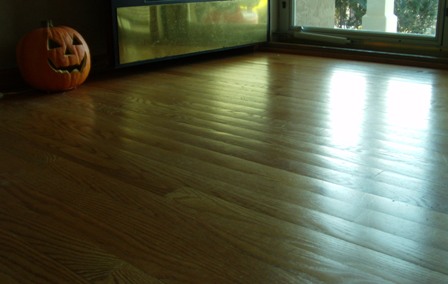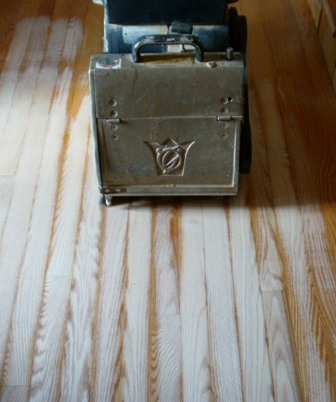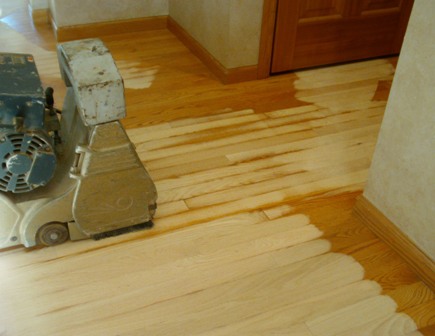Wood Floor Cupping
leads to
Crowning When Sanded

This was a wood floor cupping at the time of sanding.
Cupped or Crowned, the effect is that of a washboard, only in opposite directions.
From the photo above, you might suspect another screen door problem or a blowing rain.
However, my suspicion, having been on site and knowing the proximity of the utility room relative to the damaged portion of the floor,
is a washing machine overflowed, or a utility sink, or a supply hose to the washing machine burst.
The result? A water damage insurance claim that plays out in three parts.
Act 1
Adjuster arrives, no moisture meter. Cuts the check. Hires a very can do floor guy, (no moisture meter, either,) who can
maybe fit you into his very busy schedule, say..., tomorrow? Perfect!
But no one knows how wet the floor really is. No one knows how "dry" the floor really was. Relative moisture level varies from house to house.
(A Shipping and JobSite Audit from The Wood Floor Conservancy documents baseline conditions of your house and your new floor at the time of delivery and installation.)
All the insurance adjuster and floor sander know is that the homeowner wants a flat floor, again.
The tension builds...because wood swells when wet and each floor board is pushing its neighbor to the side, as close neighbors are prone to do under pressure.
Both edges of each board reach for the sky.
Act 2
The edges of each board are sanded off to get the floor flat.
Thus ends Act 2. and this Squeak Tragedy is really moving along quickly, isn't it? (The squeaks ARE coming. Just be patient.
Chapter 3
A year goes by and the floor looks like a washboard, again,
only in the opposite direction.
Now the edges of each board are sagging below the surface creating valleys between the boards
where mountain tops used to be, (remember last year?)
And how deep are this year's valleys? They are exactly as deep as last year's mountains were high.
So, let's do the math. Let's say you have a traditional wearlayer of 1/4", or so.
1/16" was removed from the board edges when sanded while still wet.
1/16" will be removed to get the floor flat, again.

Here is what your crowned floor will look like being returned to flat.

When the old finish is gone, so is much of your floor. You have now lost half of your wearlayer.
An engineered wood floor cupping may not be salvageable, unfortunately. Even with a generous wearlayer of 4 mm, the likely result is de-lamination.
The glue between the hardwood and substrate simply meets its tolerance.
Feel fortunate if you have a floor that CAN be sanded.
But let's put off the next sanding forever, shall we?
Might I suggest subscribing to "28 Inches--A Wood Floor Blog" There you will learn about moisture meters.
You may even find a listing of insurance adjusters who use The Wood Floor Conservancy's Shipping and Job Site Audits, someday.
For sure you will find floor guys who do.
You will learn a little about wood and what causes squeaks.
Squeaks do follow water damage. Wouldn't you like to know what fasteners weather the storm best?
OR
Return to Wood Floor Problems from Wood Floor Cupping




New! Comments
Have your say about what you just read! Leave me a comment in the box below.